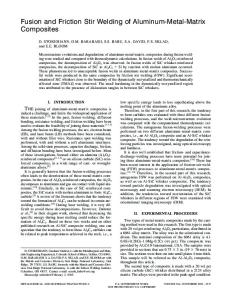Mechanical Properties of Joints in Friction Stir Welding of Aluminum Alloys
- PDF / 1,834,078 Bytes
- 6 Pages / 612 x 792 pts (letter) Page_size
- 44 Downloads / 387 Views
anical Properties of Joints in Friction Stir Welding of Aluminum Alloys A. N. Feofanova, *, V. V. Ovchinnikovb, and A. M. Gubinb aStankin
Moscow State University, Moscow, 127055 Russia Polytechnic University, Moscow, 107023 Russia *e-mail: [email protected]
bMoscow
Received January 12, 2020; revised January 27, 2020; accepted February 11, 2020
Abstract—Friction stir welding of butt joints in aluminum alloys is considered. Experiments show that, with disruption of the welding temperature and time, defects localized at the boundary of the weld seam are observed: specifically, gaps due to the differential deformation of the seam and the matrix. Keywords: friction stir welding, aluminum alloys, welding parameters, structure, defects, strength DOI: 10.3103/S1068798X20110088
Aluminum and its alloys are widely used in manufacturing on account of benefits such as low density and high strength and the possibility of adjusting the properties by appropriate alloying and subsequent treatment. In the aerospace industry, aluminum–magnesium alloys with up to 6.8% Mg are extensively used. Al–Mg alloys such as AMg3, AMg5, AMg6, AMg61, and 1565ch are well suited to fusion welding [1–4]. The formation of pores and inclusions of metal film in the seam cannot always be avoided, however [5–7]. No such defects are seen after welding in the absence of liquid. The most promising method of this type is friction stir welding [8–11]. In the past decade, this method has been widely adopted because the weld seam is formed by plastic flow of the material at the boundary of the surfaces to be welded, under the action of a rotating tool. By that means, butt and lap joints of plates and tubes may be obtained; automation is simple. Friction stir welding has been introduced at the industrial level in Europe, Japan, and China, as well as at some Russian enterprises. However, its wider adoption is hindered by our poor understanding of the interaction between the tool and welded metal. The heat and mass transfer and intense plastic deformation that occur simultaneously are multifactorial processes, while structure formation in the weld seam is complex. Accordingly, it is difficult to develop effective systems for friction stir welding. We need to determine the relation between the strength of butt joints in Al–Mg alloys and the welding parameters. In the present work, we study the structure formation in the weld seam during friction stir welding and the relation between the welding parameters and the quality of the joint for 1565ch Al–Mg alloy.
In many studies, the conditions of friction stir welding are characterized by the tool advance per turn [12–14]. By means of that parameter, the welding conditions may be compared for different aluminum alloys and for plates of the same alloy that are of different thickness. We investigate deformable industrial 1565ch Al–Mg alloy without heat treatment, in the form of rolled sheets (thickness 5 and 8 mm) [15]. Butt-welded samples of sheets are produced in industrial trials at Sespel (Cheboksary), with a
Data Loading...











